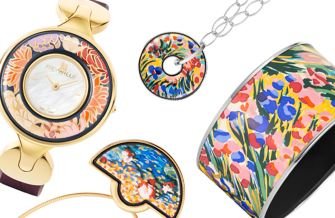Impressionism: Claude Monet
Luxury Retail Client: Print Materials, Website
At the end of the 19th century, all French art was controlled by the Académie des Beaux-Arts, a society of artists and scholars that dictated style, technique and subject matter. Portraits and historical and religious themes were valued; landscapes and still life images were not. The Académie preferred realistic images, carefully and perfectly finished, in muted tones. Each year, it held a juried show, the Salon de Paris. If an artist’s work was displayed there, he won prizes, commissions and prestige. If his work wasn’t accepted, his career progressed with difficulty.
In the early 1860s, four young painters—Claude Monet, Pierre-Auguste Renoir, Alfred Sisley, and Frédéric Bazille, jointly turned their backs on the Academie. They would choose their own subjects and work in their own way. At the same time, many European artists were starting to paint en plein air—not just sketch in the country, but paint. The idea was to put what one sees on canvas immediately, so as not to lose the action and emotions of the moment. This meant painting at speed, using quick, short brushstrokes. It meant more light, more shadow, and overall visual effect rather than detail and contour. At this time, brilliant synthetic paints had become available; the artists of this new movement took advantage of pure, unmixed colour and created paintings that vibrated with energy. As the movement gained steam, one artist emerged as its master. And one of his paintings gave this new style its name: Impression, Soleil Levant by Claude Monet.
CLAUDE MONET
Claude Monet was born in Paris in 1840, but grew up in Le Havre, where he started sketching early—he was selling charcoal caricatures at age 10. He received some artistic instruction here; he learned to use oil paints and to paint en plein air. Eventually, he returned to Paris.
War broke out, Claude spent two years in the cavalry, and then returned to Paris and began studying art. He married, had children, and the family lived in poverty while he tried to make his way. Slowly, through participation in group shows and connections with art dealers, his fortunes improved.
Hommage a Claude Monet
Shortly after his first wife died, he took up with the woman who would become his second wife. Between them, they had eight children; it was necessary that he find a large house. Eventually, he was able to rent a house at Giverny. Then, as his paintings continued to sell, he was able to buy it, and expand it, buy surrounding land and improve it further.
Monet became devoted to his garden at Giverny, which he transformed into a paradise of flowers, trees and ponds. The place was bursting with exotic plants like wisteria, irises, roses and water lilies, one of his preferred flowers. Monet never lost his fascination for his garden; he started to paint its ever-changing images in, and kept painting them for the rest of his life. He died in 1926, but millions of people continued, and continue, to visit his fabulous garden


